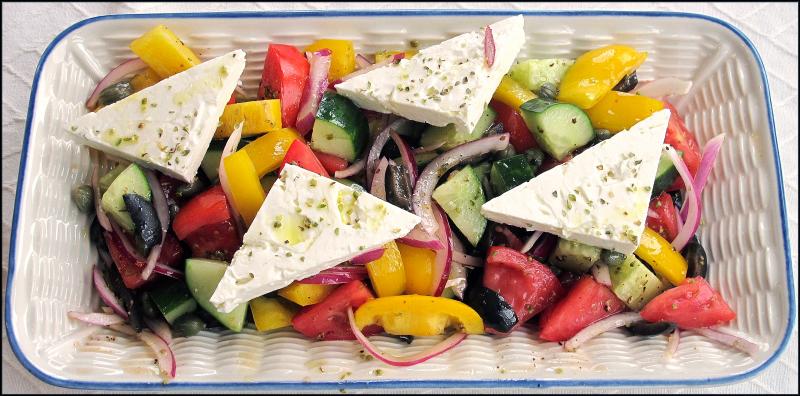Lose the lettuce and savor an authentic Greek salad
I’ve recently learned that all those Greek salads I’ve ordered at diners, delis and chain restaurants were not the real thing. If you’ve ever eaten a restaurant-made Greek salad, you’ve noticed that it started with a bed of lettuce, typically topped with a signature set of ingredients: feta cheese, salty olives, stuffed grape leaves, tomatoes and sometimes pepperoncini. The usual dressing is a bland vinaigrette.
According to Steve Dunn at Cook’s Illustrated, all of this is wrong, especially the lettuce. A true Greek salad, known as horiatiki salata or “village salad,” is a colorful collection of fresh vegetables, each of which plays an important role in the dish. To begin, find the reddest, ripest tomatoes available, cut them into chunks and toss them with a generous sprinkle of salt.
Place the tomatoes in a colander and allow the juice to drain off. This will season the tomatoes and prevent their juices from saturating the other ingredients. The next step is to gently mellow the harsh bite of thinly sliced onion without losing any of its crisp texture. I’ve seen recipes that advocate soaking them in vinegar, but this overly softens them and adds sourness. The easiest approach is to soak them in ice water for about 15 minutes, then drain off the water.
One of the traditional ingredients I just couldn’t bring myself to include when we made the salad in the photo was green bell pepper. Despite Dunn’s enthusiastic endorsement of green pepper, I just don’t like the grassy bitterness it adds wherever it goes. I opted instead to substitute yellow bell pepper – not as sweet as red, not as vegetal as green, just the right crunch to balance the tomato, cucumber and olives.
Another important feature of the salad is the use of dried, not fresh oregano. This choice gives a subtle, more delicate seasoning to the salad than with the stronger, more pungent fresh herb. The final ingredient decision is the cheese. You can find all sorts of feta cheese for sale in the markets. Don’t ever choose crumbled, as it has added preservatives and anti-caking agents.
Look for genuine Greek feta, which is made according to national standards and from at least 70 percent sheep’s milk, with the balance from goat’s milk. This results in a deep, complex flavor profile from the savory, high-fat milk. Don’t purchase nonfat or low-fat feta, as those options defeat the purpose since they don’t have the desirable richness.
Unfortunately, it’s challenging to find authentic Greek feta at the markets in our area. I have purchased feta in a large tin from Semra’s Restaurant in Rehoboth, and from time to time have found the real thing at The Fresh Market. Although there are online suppliers, the cost of shipping is very high, and the need for adequate refrigeration in the summer makes it inadvisable.
The final note about assembling this salad is how you layer the dressing. Instead of an emulsified vinaigrette, the better approach is to first toss the vegetables with a mixture of vinegar and seasoning. You can use red wine vinegar or a blend of red wine and Balsamic vinegar, depending upon your preference.
Olive oil is still an ingredient, but here it is added last, so it doesn’t coat the vegetables and prevent them from absorbing the vinegar mixture. For presentation, slice the feta into triangles and place them on top of the platter. Add a final sprinkle of oregano and drizzle of olive oil. You are now ready to enjoy an authentic Greek salad.
Horiatiki Salata*
1 1/2 lbs tomatoes
1/2 t salt
1/2 red onion
1 English cucumber
1 yellow bell pepper
2/3 C pitted kalamata olives
2 T capers, rinsed
2 T red wine vinegar
1 t dried oregano
1/2 t pepper
1/4 C olive oil
8-oz block feta cheese
olive oil & oregano, for garnish
Core the tomatoes, cut into 1/2-inch wedges and cut wedges in half crosswise. Place tomatoes in a colander and sprinkle with 1/2 t salt. Allow to drain for about 30 minutes. Thinly slice the onion and place in a bowl of ice water for 15 minutes; drain and place in a serving bowl. Cut the cucumber in quarters lengthwise, then cut into 1/2-inch chunks; add to the serving bowl. Stem and seed the pepper, cut into 2-by-1/2-inch strips; add to the serving bowl. Add olives, capers and drained tomatoes to the serving bowl. In a small bowl, whisk together vinegar, oregano and pepper. Pour mixture over the vegetables and toss to combine, then drizzle with olive oil and toss gently to coat. Slice feta into 1/2-inch-thick slices and then into triangles. Arrange over vegetables. Garnish with a drizzle of olive oil and a sprinkle of oregano. Yield: 4 servings. *Adapted from Cook’s Illustrated.
Marinated Campari Tomatoes
1/2 lb Campari tomatoes
1/4 red onion
1 garlic clove
pinch salt
1 T Balsamic vinegar
1 T lemon juice
2 T olive oil
1 T chopped fresh basil
Quarter the tomatoes and place in a bowl. Thinly slice the onion and add to the bowl. Peel the garlic clove and place it on a cutting board. Use the flat side of a knife to smash it, then mince. Sprinkle with salt and mix into a paste. In a small bowl, whisk together Balsamic, lemon juice and garlic. Stir into tomato mixture. Drizzle with olive oil and basil leaves; toss to combine. Allow to marinate for about an hour at room temperature. Use as a topping for grilled fish or chicken, or mix with mashed avocado and spread on toast. Yield: 1 C.





















































